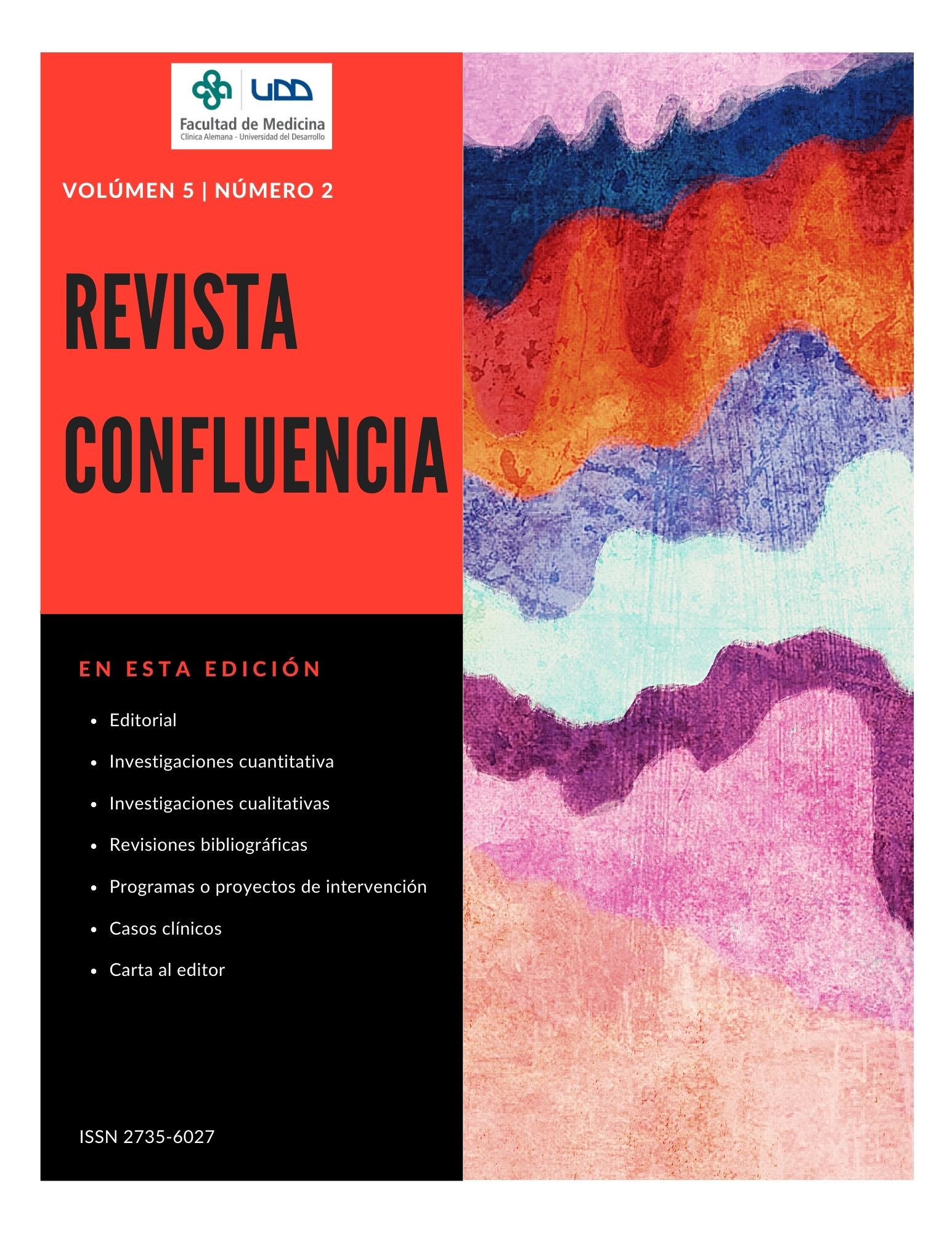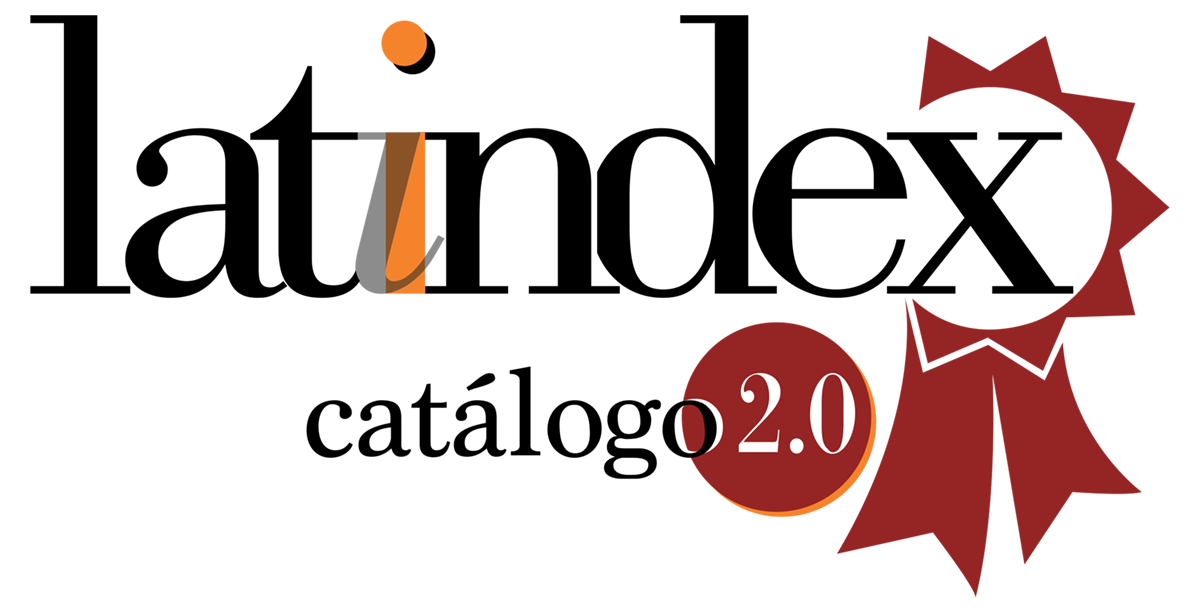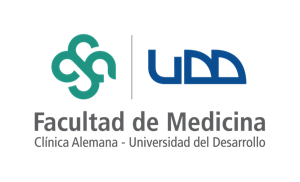Adult foreign body impaction: 11 years of experience in a tertiary center.
DOI:
https://doi.org/10.52611/confluencia.num2.2022.840Palabras clave:
Steakhouse syndrome, Eosinophilic esophagitis, Gastrointestinal symptomsResumen
Background/aims: Impaction of an esophageal foreign body is a medical emergency. Its incidence in recent years has increased. Symptoms include dysphagia, aphagia, chest pain, among others. The treatment of choice is endoscopic extraction. Complications such as perforations, erosions or fistulas have been described. The aim of this study is to characterize the clinic and endoscopic profile of adult patients who consult for this pathology in a tertiary center. Methods: Case series of patients aged over 15 years between 2008-2019 attended in the emergency room of Clínica Alemana de Santiago with suspected or confirmed esophageal foreign body impaction. Electronic clinical records, endoscopic reports and biopsies were reviewed. A descriptive analysis of the data was performed. Results: A total of 324 cases were analyzed. 60,5% of the cases underwent urgent upper gastrointestinal endoscopy. The most frequently reported symptoms were foreign body sensation (67,9%) and hypersalivation (35,4%). The most frequent type of foreign body found was red meat (36,7%). A significantly higher incidence of esophageal foreign body was observed on weekends. Eosinophilic esophagitis was suspected in 37%, there were no cases of malignancy. Complications were rare in our series (0,2%). Conclusion: Eosinophilic esophagitis was the most frequent underlying condition in this series. The results may account for some cultural aspects in the population of the study. Emergency endoscopic therapy is safe and effective. Limitations of this study include the retrospective character. A prospective study to propose a protocol should be developed.
Descargas
Citas
Pfau P. Removal and management of esophageal foreign bodies. Tech Gastrointest Endosc [Internet]. 2014 [cited 2022 May 7];16(1):32-9. Available in: https://doi.org/10.1016/j.tgie.2013.10.004
Ruan WS, Li YN, Feng MX, Qiang L. Retrospective observational analysis of esophageal foreign bodies: a novel characterization based on shape. Sci Rep [Internet]. 2020 [cited 2022 May 7];10:4273. Available in: https://www.nature.com/articles/s41598-020-61207-8.pdf
Birk M, Bauerfeind P, Deprez PH, Häfner M, Hartmann D, Hassan C, et al. Removal of foreign bodies in the upper gastrointestinal tract in adults: European Society of Gastrointestinal Endoscopy (ESGE) Clinical Guideline. Endoscopy [Internet]. 2016 May [cited 2022 May 7];48(5):489-96. Available in: https://doi.org/10.1055/s-0042-100456
Yao CC, Wu IT, Lu LS, Lin SC, Liang CM, Kuo YH, et al. Endoscopic Management of Foreign Bodies in the Upper Gastrointestinal Tract of Adults. Biomed Res Int [Internet]. 2015 [cited 2022 May 7];2015:658602. Available in: https://doi.org/10.1155%2F2015%2F658602
Tseng CC, Hsiao TY, Hsu WC. Comparison of rigid and flexible endoscopy for removing esophageal foreign bodies in an emergency. J Formos Med Assoc [Internet]. 2016 Aug [cited 2022 May 7];115(8):639-44. Available in: https://doi.org/10.1016/j.jfma.2015.05.016
Aiolfi A, Ferrari D, Riva CG, Toti F, Bonitta G, Bonavina L. Esophageal foreign bodies in adults: systematic review of the literature. Scand J Gastroenterol [Internet]. 2018 Oct-Nov [cited 2022 May 7];53(10-11):1171-8. Available in: https://doi.org/10.1080/00365521.2018.1526317
Hong KH, Kim YJ, Kim JH, Chun SW, Kim HM, Cho JH. Risk factors for complications associated with upper gastrointestinal foreign bodies. World J Gastroenterol [Internet]. 2015 Jul 14 [cited 2022 May 7];21(26):8125-31. Available in: https://doi.org/10.3748%2Fwjg.v21.i26.8125
Schupack DA, Lenz CJ, Geno DM, Tholen CJ, Leggett CL, Katzka DA, et al. The evolution of treatment and complications of esophageal food impaction. United European Gastroenterol J [Internet]. 2019 May [cited 2022 May 7];7(4):548-556. Available in: https://doi.org/10.1177/2050640619836052
Béjar M, Cevo J, Romero I, Iñiguez SR. Mortalidad nacional en otorrinolaringología. Rev Otorrinolaringol Cir Cabeza Cuello [Internet]. 2007 [cited 2022 May 7];67:31-7. Available in: http://dx.doi.org/10.4067/S0718-48162007000100006
Pastén G. Albert, González F. Bárbara, González J. Pablo, Figueroa R. Óscar. Enfrentamiento de la ingesta de cuerpo extraño en un Hospital Regional del sur de Chile. Rev Chil Cir [Internet]. 2018 Dic [cited 2022 May 7];70(6):517-22. Available in: http://dx.doi.org/10.4067/s0718-40262018000600517
ASGE Standards of Practice Committee, Ikenberry SO, Jue TL, Anderson MA, Appalaneni V, Banerjee S, et al. Management of ingested foreign bodies and food impactions. Gastrointest Endosc [Internet]. 2011 Jun [cited 2022 May 7];73(6):1085-91. Available in: https://doi.org/10.1016/j.gie.2010.11.010
Shuja A, Winston DM, Rahman AU, Mitty RD, Jaber BL, Keo T. Esophageal food impaction during cultural holidays and national athletic events. Gastroenterol Rep (Oxf) [Internet]. 2017 Feb [cited 2022 May 7];5(1):43-46. Available in: https://doi.org/10.1093/gastro/gow041
Zhong Q, Jiang R, Zheng X, Xu G, Fan X, Xu Y, et al. Esophageal foreign body ingestion in adults on weekdays and holidays: A retrospective study of 1058 patients. Medicine (Baltimore) [Internet]. 2017 Oct [cited 2022 May 7];96(43):e8409. Available in: https://doi.org/10.1097/md.0000000000008409
Ciriza C, García L, Suárez P, Jiménez C, Romero MJ, Urquiza O, et al. What predictive parameters best indicate the need for emergent gastrointestinal endoscopy after foreign body ingestion? J Clin Gastroenterol [Internet]. 2000 Jul [cited 2022 May 7];31(1):23-8. Available in: https://doi.org/10.1097/00004836-200007000-00006
Crockett SD, Sperry SL, Miller CB, Shaheen NJ, Dellon ES. Emergency care of esophageal foreign body impactions: timing, treatment modalities, and resource utilization. Dis Esophagus [Internet]. 2013 Feb-Mar [cited 2022 May 7];26(2):105-12. Available in: https://doi.org/10.1111/j.1442-2050.2012.01344.x
Sperry SL, Crockett SD, Miller CB, Shaheen NJ, Dellon ES. Esophageal foreign-body impactions: epidemiology, time trends, and the impact of the increasing prevalence of eosinophilic esophagitis. Gastrointest Endosc [Internet]. 2011 [cited 2022 May 7];74(5):985-91. Available in: https://doi.org/10.1016/j.gie.2011.06.029
Dellon ES. Eosinophilic esophagitis: diagnostic tests and criteria. Curr Opin Gastroenterol [Internet]. 2012 Jul [cited 2022 May 7];28(4):382-8. Available in: https://doi.org/10.1097/mog.0b013e328352b5ef
Fung BM, Sweetser S, Wong Kee Song LM, Tabibian JH. Foreign object ingestion and esophageal food impaction: An update and review on endoscopic management. World J Gastrointest Endosc [Internet]. 2019 [cited 2022 May 7];11(3):174-92. Available in: https://doi.org/10.4253/wjge.v11.i3.174
Descargas
Publicado
Cómo citar
Número
Sección
Licencia
Derechos de autor 2022 Revista Confluencia

Esta obra está bajo una licencia internacional Creative Commons Atribución-NoComercial-SinDerivadas 4.0.









